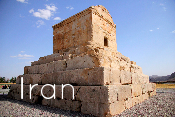**We’re currently enjoying the end of 2012 with my family in Oklahoma before we move to San Diego in January. Here, I get back to my last few posts about my six-week backpacking trip through Iran.**
One of my major goals in blogging about Iran is to show our readers the real Iran — the one not depicted in the news and the one so few are familiar with. I mean, would you have ever guessed early traces of wine came from Shiraz? And that Iran is home to a poetic, laid-back city like Shiraz? Well, my open love letter to Shiraz continues now. Here, I share with you the nine places — ones with history, culture and stunning nature — that everyone should know.
Aramgah-e Hafez or Tomb of Hafez. Look at the books in an Iranian’s home and you’ll almost always find a book of Hafez’s poems. Hafez, who lived from 1325-1389, is one of Iran’s most beloved poets, who frequently penned verses of the mystical nature. His tomb, an octagonal structure with a beautiful tiled ceiling, is a pilgrimage site for many.
My friend introduced me to this man who spends a lot of time at the tomb. He loves Hafez, but funnily enough, he told me hasn’t read much of Hafez’s works. He relies instead on the spiritual connection and force he gains when he holds the books.
Aramgah-e- Shah-e Cheragh. This mosque is set in a beautiful courtyard that’s a perfect place to just “take it all in,” but the real draw is the retina-blinding mirror tile work inside. I challenge you to find a glitzier holy site.
Qalat. This ancient village located 45 minutes from Shiraz is a popular weekend getaway for Shirazis and for good reason thanks to mountains, waterfalls, pomegranate trees and hiking trails all to be enjoyed while sipping exotic teas, drinking sharbats (sweet herbal drinks with health benefits) and smoking hookah. I mean, it doesn’t get much better than barbecuing kebabs next to a waterfall. There are even a couple of small modern art galleries!
A piece from one of the galleries.
Citadel of Karim Khan. This picture doesn’t really do the citadel of ruler Karim Khan justice, but trust me when I say it’s huge. It was built in the mid 1700s and features a lovely courtyard with a pool and fruit trees inside.
Tomb of Cyrus. Cyrus the Great, considered one of the greatest leaders in Persian history, was the father of the Persian empire when it was established 2,500 years ago. His 30-year-rule established the Iran that stands today, and his tomb can be seen in nearby Pasargadae which was the first capital of the Persian empire. 
Bathhouse. You can either take a shower yourself or have one of the workers scrub you down and give you a massage. It’s less homoerotic than you think! It’s actually a traditional bathhouse where the massages are more in the vein of painful and muscle-wrenching than relaxing. I couldn’t snap a lot of photos at this place — I’m sure you understand and also, not sure you’d want to see that anyway — but I did manage to get a shot of my guy.
Persepolis. If you haven’t heard of Persepolis, well…shame on your world history teacher. The ancient city, dubbed a UNESCO World Heritage Site, dates back to 500BC and is filled with spectacular relics from the grand Achaemenid Empire that rival the more commonly known sites of ancient Egypt. What you can see now are remnants of the once glorious palace and the bass reliefs, which are still in quite good condition.
Rock tombs at Naqsh-e Rostam. Another relic from the Achaemenid Empire in Persepolis, the grand rock tombs, which allegedly house four great kings (only three are pictured below). It’s a beautiful site made all the more grand by its setting on a high cliff.
Zurkhaneh or house of strength. This 3,000-year-old exercise is, as Lonely Planet calls it, “a mix of sport, theater and religion.” As a leader pounds on a drum while reciting verses from the Persian epic, the Shahnameh, men stand in a circle, performing various feats of strength. Back in the day, when the zurkhaneh was frequented to prep for battles, weights would be covered in spikes; the equipment is a little less austere these days. You can usually watch for free, as it’s open to the public, and while local women aren’t often seen there, Western women are welcomed.

















